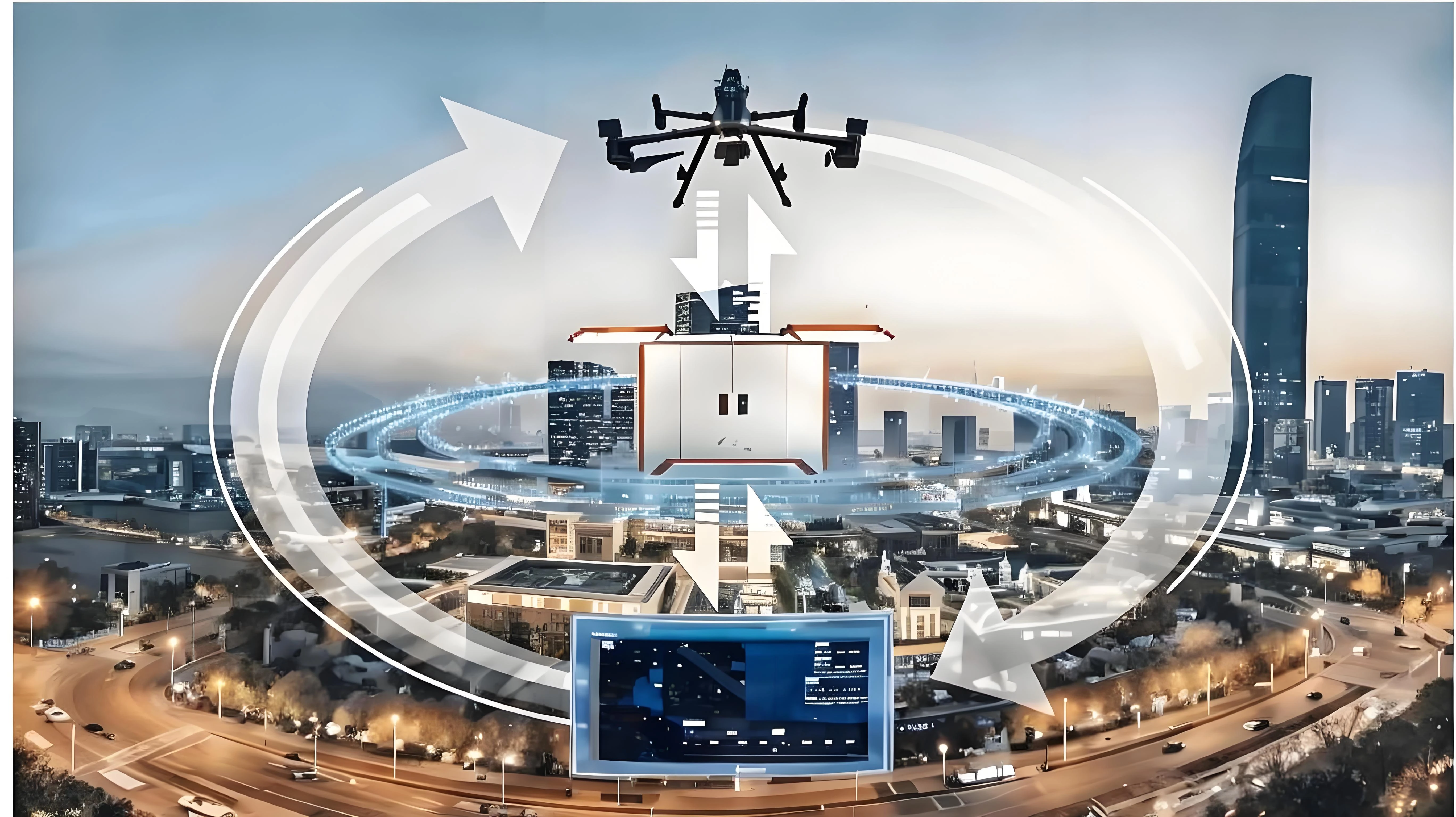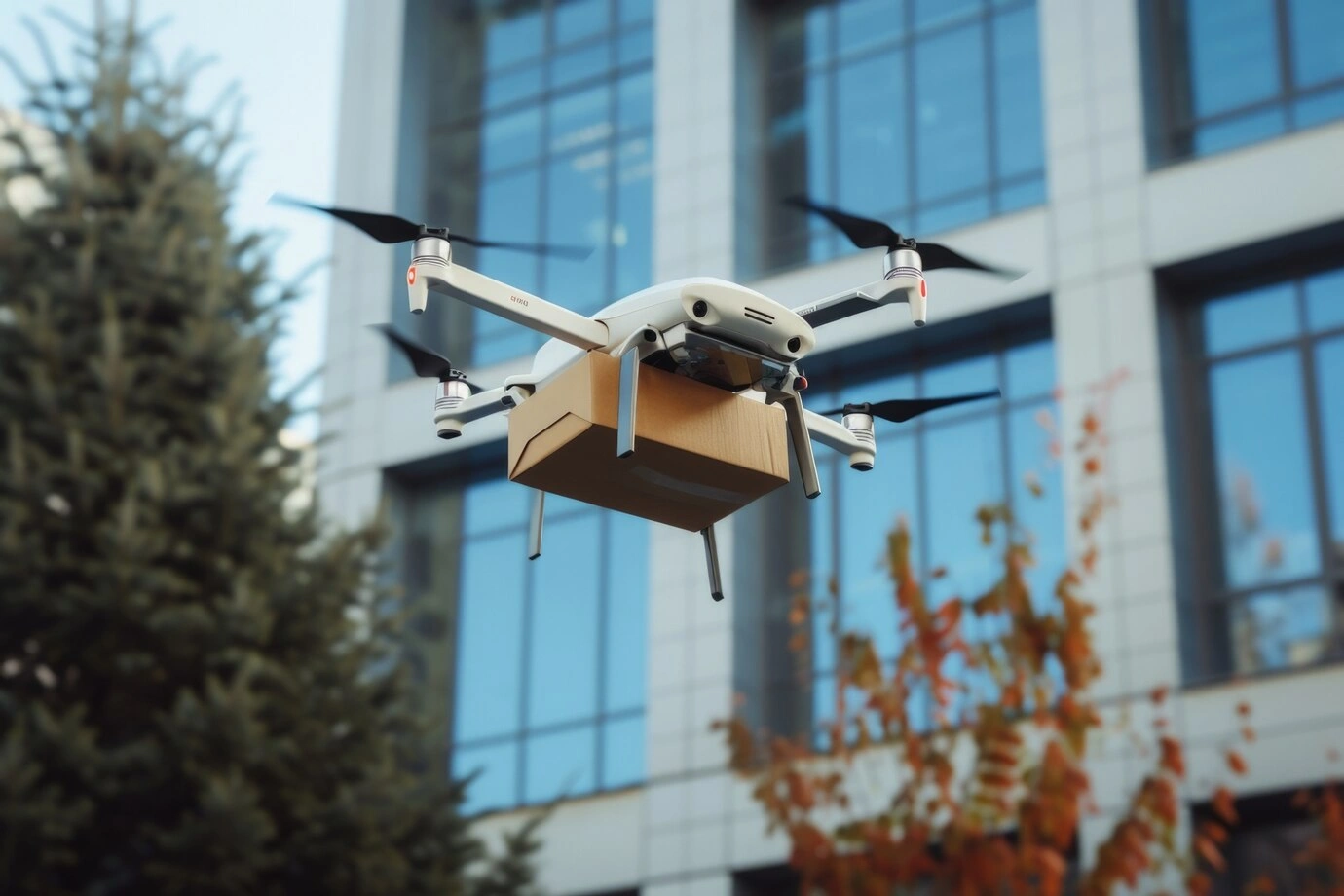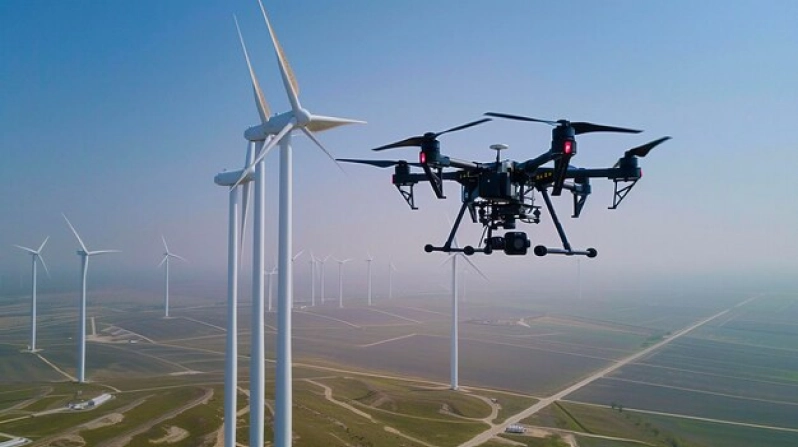Drones, once considered an unreachable high-tech innovation, have now become an integral part of our daily lives and essential tools across various industries. From doorstep deliveries to environmental monitoring, from farmlands to cities, drones are rapidly transforming the way we work and live. With advancements in technologies like artificial intelligence (AI) and 5G, drones are expanding their functionalities and applications at an impressive pace, bringing more innovation and convenience. This article takes you into the world of drones to explore how they integrate with other emerging technologies to drive future development.
What Is a Drone?
A drone, or unmanned aerial vehicle (UAV), is an aircraft that operates without a human pilot on board. Widely used in fields such as military, commercial delivery, agriculture, and environmental protection, modern drones are typically equipped with high-definition cameras, sensors, and other devices. These enable drones to collect real-time data, perform image recognition, and plan flight paths to complete precise tasks.
The rapid development of drones is fueled by lightweight materials and advanced battery technologies, making them lighter and capable of flying longer distances. At the same time, cutting-edge electronic controls and intelligent sensing technologies allow drones to navigate complex environments, perform stable flights, and execute precise operations. Continuous advancements in flight control software have enhanced drones’ autonomous flying and decision-making capabilities, enabling them to complete complex tasks without human intervention. These technological improvements significantly reduce operational costs and have broadened drones’ applications across multiple industries.
How Emerging Technologies Propel Drone Development
The rapid progress of drones is closely linked to support from emerging technologies like AI, the Internet of Things (IoT), and blockchain. These innovations not only enhance drone functionality but also expand their application scenarios.
- Artificial Intelligence (AI): AI equips drones with powerful data analysis and decision-making capabilities. Through machine learning, drones can identify objects, plan flight paths, and provide intelligent solutions for industries like logistics and agricultural monitoring.
- Internet of Things (IoT): IoT enables drones to exchange real-time data with other devices, boosting their efficiency in applications like smart cities, environmental monitoring, and emergency response.
- Blockchain: Blockchain ensures data security and privacy when drones transmit sensitive information. This is particularly valuable in industries like finance and healthcare, where data integrity is critical.
Technological Innovations of Drones in High-Altitude Cleaning
Drones are revolutionizing high-altitude cleaning with their efficiency, safety, and cost-effectiveness, especially in challenging or hazardous environments. Equipped with high-pressure spraying systems, cleaning brushes, or specialized coating sprayers, drones can effortlessly handle tasks like cleaning building facades, solar panels, and wind turbine blades.
In building facade cleaning, cleaning drones‘ agile flight capabilities and precise operation allow them to quickly cover large wall surfaces, significantly reducing reliance on scaffolding or manual climbing. This approach not only shortens cleaning times but also minimizes safety risks for workers performing high-altitude tasks.
For solar panel maintenance, cleaning drones can perform non-contact cleaning with adjustable spray pressure to remove dust, dirt, and bird droppings, improving the panels’ energy output. Additionally, drones can collect real-time data to inspect for damage and conduct condition assessments alongside the cleaning process, greatly enhancing operational efficiency.
When it comes to wind turbine blade cleaning, cleaning drones’ ability to hover precisely and adjust flexibly enables them to reach blade surfaces that are otherwise difficult to access. They can clear dirt and ice buildup, ensuring turbines operate smoothly. This method reduces downtime and significantly lowers cleaning costs compared to traditional techniques.
Drone Applications in Logistics
Drones are emerging as a game-changing tool in the logistics sector, particularly in areas with heavy traffic or challenging terrains. They can complete package deliveries quickly and safely, bypassing traffic congestion or impassable routes. With unmatched speed and flexibility, drones excel in scenarios like emergency supply transport, rapid deliveries, and last-mile logistics, fulfilling tasks that conventional methods cannot respond to promptly.
The integration of drones into logistics has drastically improved delivery efficiency while reducing reliance on manpower and ground transportation resources, lowering overall operational costs. In remote areas, mountainous regions, or disaster-stricken zones, traditional logistics often struggle due to poor infrastructure or limited accessibility. Drones’ high-altitude flight capabilities overcome these barriers, enabling fast and precise delivery of goods.
Following natural disasters, drones can act as first responders, quickly delivering medical supplies, food, and water to affected areas. Their ability to provide rapid support during disaster relief operations helps rescue teams work more effectively and efficiently.
Drone Technology in Agriculture
With advancing technology, drones are becoming increasingly important tools in agriculture, helping farmers improve efficiency, optimize resource use, and boost crop yields. Equipped with various sensors such as soil moisture sensors, weather sensors, high-definition cameras, and infrared sensors, drones enable comprehensive monitoring of farmland. By collecting real-time data on soil conditions, weather patterns, and crop health, drones empower farmers to manage every aspect of agricultural production with precision.
High-resolution cameras and infrared imaging technology allow drones to capture subtle changes in crop health and growth. For instance, drones can detect water stress or early signs of pests and diseases through infrared imaging, enabling farmers to take preventive measures promptly. The data gathered is transformed into detailed maps, helping farmers optimize irrigation, fertilization, and pesticide application strategies. This ensures every part of the field receives the right amount of resources, reducing overuse, improving efficiency, and minimizing environmental impact.
Drones can also generate regular or on-demand crop growth reports, covering information like soil moisture levels, crop health, and potential risks. These reports give farmers a real-time understanding of field conditions and help them adjust their practices accordingly. By providing scientific decision-making support, drones significantly enhance precision in crop management, ensuring healthy growth and enabling efficient, sustainable agricultural production.
Drone Applications in Environmental Protection
Amid global climate change and growing environmental challenges, drones are playing an increasingly vital role in conservation. They assist scientists in monitoring ecosystems, tracking animal migration paths, evaluating habitat changes, identifying pollution sources, and responding to natural disasters in a timely manner.
Without disturbing ecosystems, drones equipped with high-resolution cameras, infrared sensors, and gas detectors can collect vast amounts of real-time environmental data. This data helps researchers assess the health of plants and animals and monitor air pollution, water quality changes, and greenhouse gas emissions. For example, drones equipped with infrared imaging can quickly locate and track wildfires, issuing early warnings to aid firefighting efforts. In flood monitoring, drones can operate in extreme weather, capturing aerial images and analyzing water levels to provide critical data for emergency response teams.
Drones also play a unique role in protecting endangered species. By monitoring habitat changes and tracking migration routes, they provide valuable data for managing ecological reserves. Drones are also effective tools for combating illegal activities like poaching and mining. Their high-altitude surveillance capabilities enable comprehensive patrols of human activity areas, detecting signs of illegal actions and transmitting real-time data to enforcement teams. This precision helps protect ecological balance and biodiversity.
Innovations of Drones in Entertainment and Media
Drone technology is revolutionizing the entertainment and media industry, offering filmmakers and photographers unprecedented shooting perspectives and creative freedom. With the high-altitude flying capabilities and maneuverability of drones, visual content now transcends the limitations of traditional equipment, capturing breathtaking footage and unique angles that enhance the variety and richness of visual storytelling. For instance, drones can execute prolonged aerial flights, capturing expansive landscapes or tracking fast-moving scenes, delivering immersive visuals that captivate audiences.
Drone filming enables production teams to achieve angles and details previously unattainable with conventional methods. From panoramic views spanning mountain ranges or city skylines to close-up dynamic action sequences, drones unlock new storytelling dimensions, enriching the visual experience and expanding the creative potential for filmmakers. This innovative tool helps narrate more vivid and layered stories, providing viewers with fresh and exhilarating perspectives.
Moreover, drones play an indispensable role in live sports broadcasts and news reporting. In rapidly evolving sports scenarios, drones can track athletes’ movements in real time, offering aerial views that surpass the impact of traditional broadcasts. For example, drones can follow players’ trajectories during soccer matches, capturing dynamic scenes, or highlight critical moments in extreme sports from above with precision. In journalism, especially during breaking news or significant events, drones provide reporters with the agility and immediacy to capture on-site aerial footage, ensuring timely and accurate reporting.
Integration of Drones with 5G Networks
The advent of 5G networks has brought transformative advancements to drone technology. Compared to 4G, 5G offers faster transmission speeds and lower latency, enabling drones to transmit high-definition images, videos, and large datasets in real time. This seamless, high-speed connection allows drones to adapt to environmental changes swiftly, facilitating efficient data analysis for applications like real-time monitoring, disaster response, and agricultural management. With 5G, drones are no longer constrained by short-range operations; remote control and cross-regional missions become feasible, unlocking vast potential for drone applications.
The high reliability and extensive coverage of 5G networks also significantly enhance drone operational safety. Under traditional wireless networks, signal disruptions or disconnections often pose risks to drone flights, particularly in complex environments. In contrast, 5G ensures stable data transmission during flights, minimizing accident risks caused by signal loss. This reliability is critical for drones performing high-stakes tasks, providing operators with consistent flight data and enabling timely decision-making.
Additionally, 5G’s low latency and high bandwidth facilitate collaborative operations among multiple drones. By sharing flight data and analysis results in real time, drone fleets can work in unison, improving task efficiency. For example, in large-scale logistics and complex environmental monitoring missions, 5G networks enable drone swarms to operate synchronously, enhancing accuracy and speed. This fusion of technologies drives deeper integration of drones into logistics, smart city development, agricultural management, and beyond, paving the way for further innovation and expanded possibilities.
Applications of Drones in Construction and Infrastructure
In the construction industry, drones provide critical support for project monitoring and management by offering aerial perspectives. Equipped with high-precision sensors and imaging devices, drones can rapidly generate detailed 3D models that assist engineers in design evaluation and construction planning. These models enable project teams to track progress more accurately, identify potential issues promptly, and make necessary adjustments during the construction process.
Drones’ capabilities in measurement and data collection significantly improve work efficiency. They can survey large areas in a short time, drastically reducing the time and labor required for manual measurements. For large-scale projects, acquiring real-time terrain, structural, and environmental data helps optimize designs and construction workflows, minimizing human error and increasing the project’s precision and safety.
In infrastructure inspection and maintenance, drones play a crucial role. With high-definition cameras and infrared sensors, drones can conduct aerial inspections of bridges, tunnels, power towers, and other facilities, detecting structural cracks, corrosion, and potential hazards. This precise inspection method allows maintenance personnel to identify issues early and take corrective actions, reducing accident risks and ensuring public safety.
Drones in Smart City Development
As urbanization accelerates, drones have become an indispensable part of smart city development. Their applications in traffic monitoring, environmental monitoring, and public safety significantly enhance the efficiency and intelligence of urban management.
In traffic management, drones can monitor traffic flow in real time, automatically identifying traffic congestion, accidents, and violations. By providing high-definition images and data analysis, drones offer accurate traffic condition reports, enabling traffic authorities to adjust signals and guide vehicles to alternative routes, reducing congestion and accidents, and improving overall traffic efficiency.
For environmental monitoring, drones equipped with various sensors can track air quality, water pollution, noise levels, and other environmental factors in real time. With broad coverage and precise data collection, drones help city managers monitor environmental changes and take timely action to protect the environment. This is vital for improving residents’ quality of life and achieving sustainable, green urban development.
Drones also play a vital role in public safety. In emergencies, drones provide aerial views for rapid assessments of fires, disasters, or crime scenes. During large public events or emergency rescue operations, drones can quickly relay real-time information, aiding response teams in making accurate decisions, and enhancing the overall efficiency and safety of emergency responses.
Through real-time data transmission and intelligent analysis, drones not only accelerate urban management responses but also contribute to the development of smarter, more efficient, and safer cities. They provide urban managers with more precise and comprehensive information, driving the modernization and digital transformation of urban management.
Deep Integration of Drones and AI
The integration of drones with artificial intelligence (AI) technology is driving a transformation in both production and daily life. With the support of AI algorithms, drones are equipped with the ability to autonomously navigate, recognize objects, perceive their surroundings, and make intelligent decisions, enabling them to efficiently tackle complex tasks.
Through deep learning techniques, drones can analyze their environment in real time, identify target objects, and dynamically plan flight paths. For instance, in logistics and delivery, drones can autonomously avoid obstacles, while in agricultural monitoring, they can accurately detect crop diseases and take targeted actions. Additionally, the introduction of AI enhances the drones’ data processing capabilities, enabling them to generate valuable analysis results instantaneously, which aids in decision-making.
This technological convergence significantly reduces the need for human intervention, especially in hazardous or harsh environments. In scenarios like earthquake rescue operations or fire monitoring, drones equipped with AI demonstrate higher efficiency and reliability. The collaborative development of drones and AI is opening up more innovative applications, offering intelligent solutions across various industries.
Safety and Privacy: Challenges in Drone Development
Despite the vast potential of drones across industries, their development faces significant challenges related to safety and privacy, including airspace management, data protection, and privacy risks.
To regulate drone usage, governments worldwide are accelerating the formulation of regulations, focusing on flight permissions, operational standards, and airspace allocation to minimize risks arising from drone misuse or unauthorized operations. At the same time, companies are developing advanced protective technologies, such as autonomous obstacle avoidance systems, encrypted communication protocols, and real-time monitoring features, to enhance drone safety and reliability.
In terms of privacy protection, drone manufacturers need to closely collaborate with users and regulatory bodies to establish clear standards for data collection, storage, and sharing. For example, using anonymization techniques and blockchain encryption can ensure transparency and security in data transmission and usage, helping to reduce privacy concerns and promoting the healthy development of drone technology.
Looking Ahead: Future Trends in Drone Technology
Drone technology is advancing toward greater intelligence, automation, and multifunctionality. The use of new materials is making drones lighter and more durable, while the application of new energy technologies is significantly improving their endurance. The introduction of advanced algorithms is enhancing drones’ autonomy and decision-making capabilities. These breakthroughs will propel drones into more innovative applications across various fields, including logistics, agriculture, environmental monitoring, and disaster rescue.
In the future, drones are expected to integrate further into our daily lives, taking on tasks such as parcel delivery, urban management, and public services, bringing greater convenience and efficiency to both individuals and society. Moreover, drones will play a pivotal role in areas like smart city development and space exploration, becoming a key driver of technological progress and continually shaping a smarter, more sustainable future.
Conclusion
The integration of drones with emerging technologies is profoundly influencing the way we live and work. From logistics and precision agriculture to environmental monitoring and entertainment, drones have demonstrated immense potential and diverse application prospects. As symbols of innovation and efficiency, they not only enhance productivity across industries but also introduce new conveniences and possibilities into daily life. While exploring drone technology, the issues of safety and privacy must be addressed, as these will determine whether the industry can achieve sustainable development. In the future, drones will become more intelligent and multifunctional, integrating into our world as a significant force driving societal progress.




